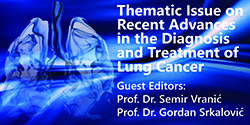Lipoma and Occult Spinal Dysraphism
Keywords:
Lipoma, Meningomyelocele, Spina Bifida Occulta, Spinal Cord, Spinal DysraphismAbstract
Congenital abnormality, an occult spinal dysraphism with spinal lipoma, is a rare dysraphic spinal abnormality. The syndrome, treatments, outcomes, and current controversies are reviewed.
Occult spinal dysraphism usually is usually manifested without clinical changes, either neurological or local changes. Local cutaneous changes associated with occult spinal dysraphism include midline lumbosacral hypertrichosis, lumbosacral cutaneous hemangiomas, lumbosacral dermal sinus and midline lumbosacral subcutaneous lipoma. Neurological changes in spina bifida occulta and spinal lipoma include local and radicular pain, asymmetric hyporeflexia, spasticity, sensory changes, weakness and bowel/bladder dysfunction. A progressive neurological/urological dysfunction limited to the conus medullaris may also suggest other spinal cord syndromes. Ultrasonography, CT scanning, MR imaging, and plain radiography assist with the localization of the conus medullaris level changes but also the identification of the specific spinal elements affected. Surgical intervention for the asymptomatic lipoma of the conus medullaris has been an area of controversy, primarily due to the paucity of studies in which the natural history of this disorder is researched in detail. Excising cutaneous changes is recommended in case of any esthetic or functional disturbances.
References
James CC, Lassman LP. Diastematomyelia and the tight filum terminale. J Neurol Sci. 1970;10(2):193-6.
Kanev PM, Bierbrauer KS. Reflections on the natural history of lipomyelomeningocele. Pediatr Neurosurg. 1995;22(3):137-40.
Soonawala N, Overweg-Plandsoen WC, Brouwer OF. Early clinical signs and symptoms in occult spinal dysraphism: a retrospective case study of 47 patients. Clin Neurol Neurosurg. 1999;101(1):11-4.
French BN. The embryology of spinal dysraphism. Clin Neurosurg. 1983;30:295-340.
Lemire, RJ, Siebert JR. Neuroembryology. In: Wilkins RH, Rengachary SS, editors. Neurosurgery Update II. New York : McGraw-Hill; 1991. p. 286-91.
Streeter GL. Factors involved in the formation of the filum terminale. Am J Anat. 1991;25(1):1-11.
McLone DG. Occult dysraphism and the tethered spinal cord lipomas. In: Choix M, Di Rocco C, Hockley A, et al, editors. Pediatric Neurosurgery. Philadelphia: Churchill Livingstone; 1999. p. 61-78.
Yamada S, Zinke DE, Sanders D. Pathophysiology of “tethered cord syndrome”. J Neurosurg. 1981;54(4):494-503.
Schropp C, Speer CP, Schweitzer T, Krauss J: Congenital Skin Lesions in Occult Spinal Dysraphism-What is Typical? Z Geburtshilfe Neonatol. 2006;210(6):222-227.
Brkić H, Moranjkić M: Lumbar lipoma and occult lumbar dysraphism. Pedijatrija danas 2007;3(1): 82-86.
James CC, Lassman LP. Spinal dysraphism. Spinal cord lesions associated with spina bifida occulta. Physiotherapy. 1962;48:154-7.
Warder DE, Oakes WJ. Tethered cord syndrome: the low-lying and normally positioned conus. Neurosurgery. 1994;(34):597-600.
Guthkelch AN. Diastematomyelia with median septum. Brain. 1974;97(4):729-42.
Lassman LP, James CC. Lumbosacral lipomas: critical survey of 26 cases submitted to laminectomy. J Neurol Neurosurg Psychiatry. 1967;30(2):174-81.
Davidoff AM, Thompson CV, Grimm JM, Shorter NA, Filston HC, Oakes WJ. Occult spinal dysraphism in patients with anal agenesis. J Pediatr Surg. 1991;26(8):1001-5.
Warf BC, Scott RM, Barnes PD, Hendren WH 3rd. Tethered spinal cord in patients with anorectal and urogenital malformations. Pediatr Neurosurg. 1993;19(1):25-30.
Pang D. Tethered cord syndrome: newer concepts. In: Wilkins RH, Rengachary SS, editors. Neurosurgery Update II. New York : McGraw-Hill; 1991. p. 336-344.
Hoffman HJ, Taecholarn C, Hendrick EB, Humphreys RP. Management of lipomyelomeningoceles. Experience at the Hospital for Sick Children, Toronto. J Neurosurg. 1985;62(1):1-8.
Oakes WJ. Management of spinal cord lipomas and lipomyelomeningoceles: newer concepts. In: Wilkins RH, Rengachary SS, editors. Neurosurgery Update II. New York : McGraw-Hill; 1991. p. 345-52.
Ammerman BJ, Henry JM, De Girolami U, Earle KM. Intradural lipomas of the spinal cord. A clinicopathological correlation. J Neurosurg. 1976;44(3):331-6.
McLendon RE, Oakes WJ, Heinz ER, Yeates AE, Burger PC. Adipose tissue in the filum terminale: a computed tomographic finding that may indicate tethering of the spinal cord. Neurosurgery. 1988;22(5):873-6.
Uchino A, Mori T, Ohno M. Thickened fatty filum terminale: MR imaging. Neuroradiology. 1991;33(4):331-3
Brown E, Matthes JC, Bazan C 3rd, Jinkins JR. Prevalence of incidental intraspinal lipoma of the lumbosacral spine as determined by MRI. Spine. 1994;19(7):833-6.
Chapman P, Stieg PE, Magge S, Barnes P, Feany M. Spinal lipoma controversy. Neurosurgery. 1999;44(1):186-92.
Colak A, Tahta K, Ozcan OE, Eryilmaz M. Congenital lumbosacral lipomas presenting as a form of occult spinal dysraphism. A report of 9 surgically treated cases. Zentralbl Neurochir. 1992;53(1):15-9.
McLone D, Thompson D. Lipomas of the spine. In: McLone D, editor. Pediatric Neurosurgery. Philadelphia : WB Saunders; 2001. p. 289–301.
Patwardhan V, Patanakar T, Patkar D, Armao D, Mukherji SK. MR imaging findings of intramedullary lipomas. AJR Am J Roentgenol. 2000;174(6):1792-3.
Cornette L, Verpoorten C, Lagae L, Van Calenbergh F, Plets C, Vereecken R, et al. Tethered cord syndrome in occult spinal dysraphism: timing and outcome of surgical release. Neurology. 1998;50(6):1761-5.
Zerah M, Pierre-Kahn A, Catala M. Lumbosacral lipomas. In: Choix M, Di Rocco C, Hockley A, Wet al, editors. Pediatric Neurosurgery. Philadelphia : Churchill Livingstone; 1999. p. 79-100.
Byrne RW, Hayes EA, George TM, McLone DG. Operative resection of 100 spinal lipomas in infants less than 1 year of age. Pediatr Neurosurg. 1995;23(4):182-6.
Kanev PM, Lemire RJ, Loeser JD, Berger MS. Management and long-term follow-up review of children with lipomyelomeningocele, 1952-1987. J Neurosurg. 1990;73(1):48-52.
Ratliff J, Mahoney PS, Kline DG. Tethered cord syndrome in adults. South Med J. 1999;92(12):1199-203.
Satar N, Bauer SB, Scott RM, Shefner J, Kelly M, Darbey M. Late effects of early surgery on lipoma and lipomeningocele in children less than 1 year old. J Urol. 1997;157(4):1434-7.






